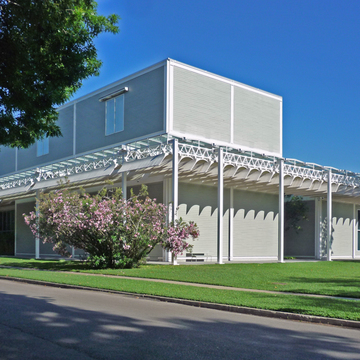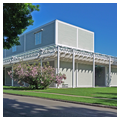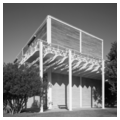At the time of John de Menil's death in 1973, he and Dominique de Menil were working with Philadelphia architect Louis I. Kahn on an ambitious scheme for a six-block museum precinct adjacent to the Rothko Chapel. After Kahn's death in 1974, Dominique de Menil had Howard Barnstone paint the 1920s bungalows and duplex apartment buildings in this precinct gray with white trim. The surreal appearance that resulted inspired Italian architect Renzo Piano, who Dominique de Menil hired in 1981. His design for the Menil Collection, produced in association with London engineers Peter Rice and Tom Barker of Ove Arup and Partners, has been acclaimed as one of the great art museum buildings of the twentieth century. The rigor and inventiveness with which the building was designed for the display and care of artworks make it a model art museum. Piano's arrestingly profiled roof platform—combining skylighting, cast-iron trusses, and stationary ferro-cement light baffles—figures against the building's simple planar walls and steel structural columns.
At 1501 Branard Avenue, across from The Menil Collection, is the Menil's Cy Twombly Gallery of 1995 by Renzo Piano Building Workshop and Richard Fitzgerald and Associates with Ove Arup and Associates. One block south of the Rothko Chapel at 4011 Yupon Street is the Byzantine Fresco Chapel Museum of 1997, an assembly of precast-concrete boxes lit from above, by Dominique de Menil's younger son, New York City architect François de Menil, with Ove Arup and Associates. Nearby, at 1416 Richmond Avenue, is the Menil's Richmond Hall of 1987, a rehabilitation by Houston architect Anthony E. Frederick of a Weingarten's grocery market designed in 1930 by Joseph Finger. Since 1998, it has contained a single installation by light artist Dan Flavin.
















